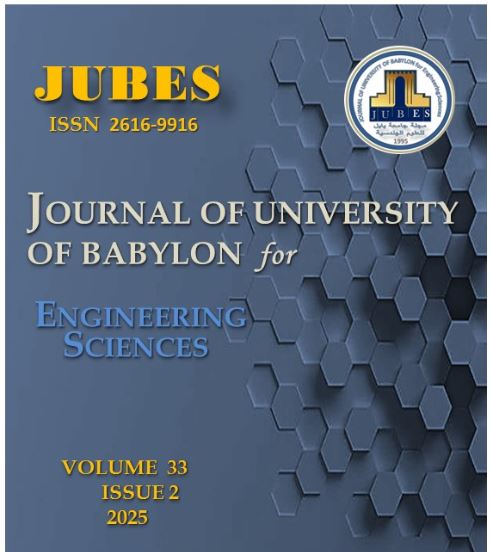Dynamical Behavior of Hybrid Kevlar/Carbon Pipe Reinforced Epoxy Conveying Water
Main Article Content
Abstract
The research included a study of the effect of reinforcement with non-continuous hybrid fibers consisting of Kevlar fibers and carbon fibers with epoxy resin on the natural frequency of pipes conveying water, as well as its effect on the maximum flow speed of water through the pipes, known as the critical speed, for different boundary conditions represented by clamped–clamped and pinned–pinned. The epoxy resin was reinforced by Kevlar fibers compared with the model reinforced by carbon fibers at the same volumetric ratios. The length of the short fiber depends on the ratio between length of short fiber and critical length of short fiber as ( L/Lc = 1, 2, ….. and 20). To obtain a hybrid composite material, both carbon fibers and Kevlar fibers were combined with the matrix material at different proportions. In the hybrid model, the structure has high stiffness in withstanding tensile stress which obtained from carbon fibers in addition to that presence of kevlar fibers in the structure design gives great toughness in resisting external impacts. The calculations were carried out using the mathematical program (MATLAB) according to Rayleigh's approximate method. It was noted that the natural frequency of the system and the critical speed of flow are greater in the carbon fiber model than in the Kevlar and hybrid fiber models. The consequence of altering the thickness and diameter of the models on the dynamic behavior of one-meter-long pipe was investigated. The study revealed that the natural frequency and critical speed increase with increasing the thickness of the pipe wall and its diameter, according to the type of fixation. The percentage of improvement in the natural frequency for pipe with different cross sections ranges from 4.9% , 9%, 12.6% to 15.8% which rises with increasing in the volume fraction of the carbon fibers in the hybrid composite materials for different fixations. Regarding the percentage of enhancement in critical velocity which ranges from 4.9% , 9.4%, 13.2% to 16.6 % as it improves with increase in the percentage of the volume fraction of carbon fibers in the hybrid pipe. A theoretical comparison was made with research that used a model with different dimensions. The results were at an acceptable difference ratio.
Downloads
Article Details
Section

This work is licensed under a Creative Commons Attribution 4.0 International License.
